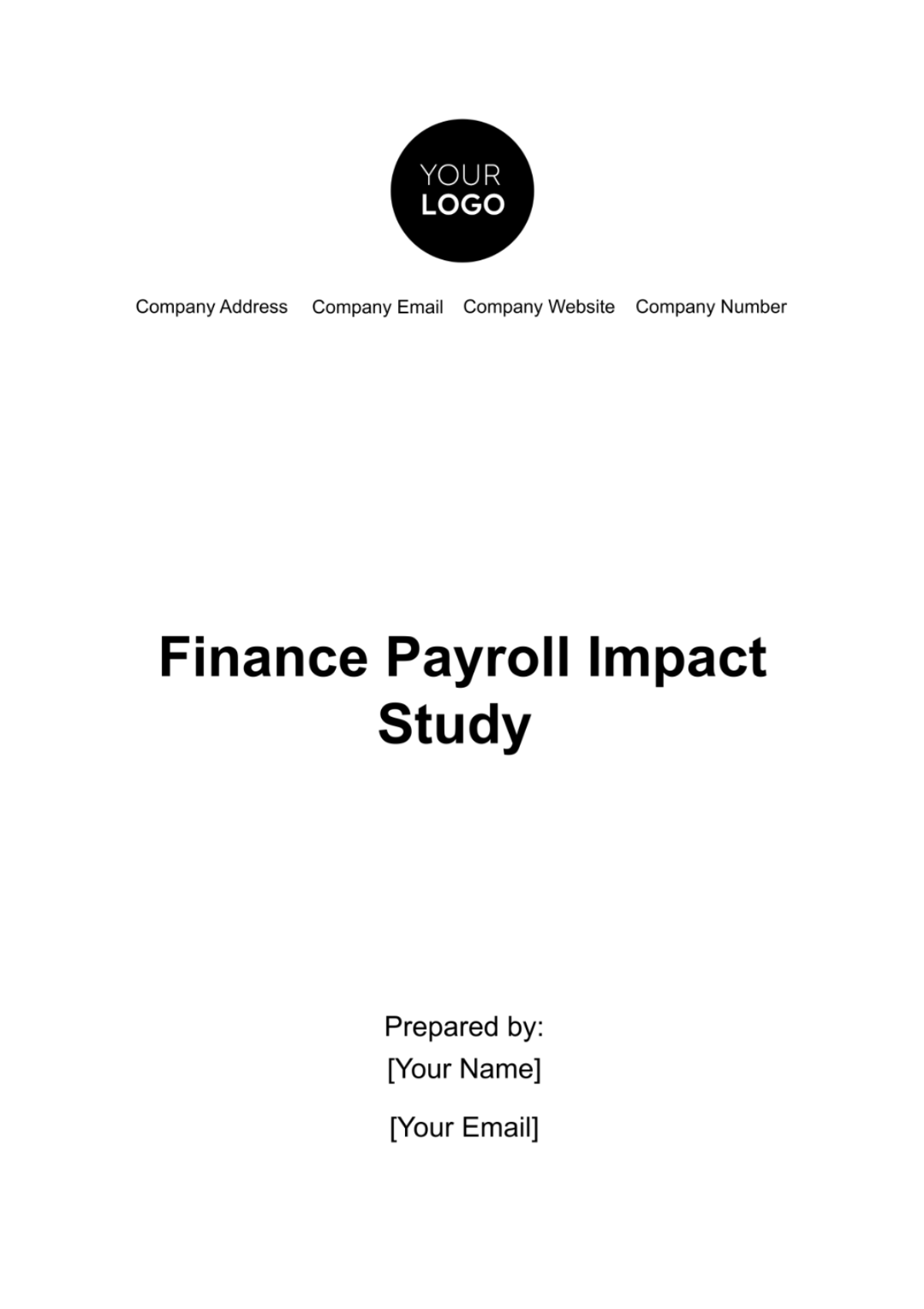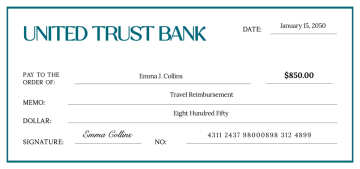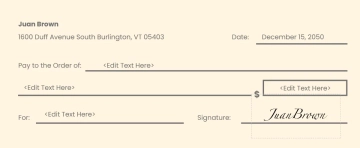Free Finance Payroll Impact Study

I. Introduction
A. Background and Rationale
In light of our dynamic business environment and the continuous evolution of regulatory frameworks, a comprehensive impact study is underway to assess the potential consequences of proposed changes to our finance payroll system. This study seeks to provide strategic insights, ensuring that modifications align with industry best practices and contribute to enhanced compliance, operational efficiency, and overall employee satisfaction.
B. Contextual Overview
As our organization has experienced substantial growth and faced evolving regulatory landscapes, updating our finance payroll system is pivotal. This initiative is driven by the need to not only meet current compliance standards but also to future-proof our processes. The impact study serves as a crucial step in aligning our payroll system with organizational objectives while maintaining a proactive approach to the industry.
II. Regulatory Compliance
A. Current Compliance Landscape
Our analysis indicates that the existing payroll system maintains commendable compliance levels with local, state, and federal regulations. This encompasses adherence to tax codes, labor laws, and the timely fulfillment of reporting obligations.
B. Proposed Changes and Compliance Analysis
Upon thorough examination, the proposed changes can lead to enhancements in tax calculation algorithms and reporting mechanisms therefore elevating the accuracy and timeliness of meeting requirements.
C. Mitigation Strategies
While the impact study revealed minimal compliance risks, we have proactively devised mitigation strategies. Ongoing collaboration with legal and compliance experts is underway to address any unforeseen challenges and ensure a seamless transition to the updated payroll system.
III. Cost Implications
The table below outlines a detailed financial impact assessment, encompassing various elements associated with the proposed changes:
Cost Category | Estimated Amount | Rationale |
[System Upgrades] | [$430,000] | [Upgrading our payroll system to the latest version is crucial to harness new features and enhance security. Failure to do so may result in compatibility issues and potential security vulnerabilities.] |
The transparent breakdown of costs fosters accountability, allowing stakeholders to comprehend the value proposition and potential return on investment associated with the updated payroll system. This meticulous financial planning positions our organization for fiscal responsibility and strategic alignment, emphasizing our commitment to efficient and sustainable business practices. By proactively addressing potential challenges, we can mitigate risks, ensuring the project's resilience in the face of unforeseen circumstances.
IV. Efficiency and Productivity
A. Current Process Efficiency
Our analysis of the current payroll process indicates a commendable level of efficiency. Processing times are reasonable, and error detection mechanisms are in place, contributing to a smooth and reliable payroll workflow.
B. Projected Efficiency Improvements
The proposed changes are anticipated to bring about significant enhancements. By incorporating advanced algorithms and automation features, we aim to further streamline payroll processing. This will not only reduce manual intervention but ensure a more efficient and error-resistant system.
C. Projected Efficiency Improvements
The proposed changes, incorporating advanced algorithms and automation features, aim to address the identified areas for improvement. Our analysis includes simulations that project a 25% reduction in processing times and a 40% decrease in error rates, showcasing tangible improvements in overall efficiency.
D. Operational Impact
During the transition, proactive measures will be implemented to ensure minimal operational disruptions. Our analysis indicates that targeted employee training programs will lead to a swift adaptation, minimizing the potential for a prolonged learning curve and maintaining operational continuity.
E. Scalability and Future Efficiency
As our organization continues to grow, the proposed changes are designed to accommodate increased transaction volumes with minimal impact on efficiency. This ensures sustained productivity gains and adaptability to future growth.
F. Implications for Stakeholders
Employees can expect a more streamlined and error-resistant payroll process, reducing the likelihood of discrepancies and ensuring timely and accurate compensation.
V. Employee Experience
A. Current Employee Experience
Our current payroll system contributes positively to employee experience, providing timely and accurate compensation. However, transparency and accessibility of payroll information are areas for improvement.
B. Impact of Proposed Changes on Employee Experience
The proposed changes aim to address the identified areas for improvement. With a more user-friendly interface, improved accessibility to payroll information, and enhanced transparency, employees can expect a seamless and satisfying experience. Timely and error-free payroll processing will contribute to increased job satisfaction.
C. Communication and Training Strategies
To facilitate a smooth transition, comprehensive communication plans and training strategies will be implemented. This includes detailed communication about the upcoming changes, FAQs to address common concerns, and tailored training programs to empower employees to confidently navigate the updated system.
D. Implications for Organizational Culture
A more user-friendly and transparent payroll system contributes to a positive work environment, fostering employee satisfaction and engagement. This, in turn, has the potential to positively impact overall organizational performance and employee retention.
E. Stakeholder Assurance
Clients and investors can be confident in our commitment to employee satisfaction, recognizing that a content and motivated workforce is essential for delivering reliable and high-quality financial services.
VI. Data Security
A. Current Data Security Measures
Our current payroll system employs robust data security measures, including encryption protocols and access controls, to safeguard sensitive financial information.
B. Implications of Proposed Changes on Data Security
The proposed changes aim to further fortify data security by implementing enhanced encryption algorithms and reinforcing access controls. Our analysis indicates a substantial improvement in data resilience, reducing the risk of unauthorized access and ensuring compliance with the latest security standards.
C. Mitigation Strategies
Proactive measures have been devised to address any potential security risks identified during the analysis. Regular audits, penetration testing, and employee training programs will be implemented to continuously monitor and strengthen data security.
D. Continuous Improvement and Incident Response
Post-implementation, a continuous improvement framework will be in place, incorporating regular security audits and incident response simulations. This ensures our ability to adapt to emerging threats promptly and reinforces a proactive stance in safeguarding sensitive financial data.
VII. Integration with Other Systems
A. Current System Integration
Our analysis of the current payroll system's integration with other financial systems reveals a satisfactory level of interoperability, ensuring seamless data flow within the organization.
B. Impact of Proposed Changes on Integration
The proposed changes aim to enhance integration further by adopting standardized data exchange formats. Our analysis indicates a more efficient and real-time data exchange between the updated payroll system and other financial systems, minimizing manual interventions and potential data discrepancies.
C. Implications for Organizational Processes
The improved integration is expected to have positive implications for organizational processes. Streamlined data flow will reduce the likelihood of errors, enhance decision-making capabilities, and contribute to a more cohesive and interconnected financial ecosystem.
D. Flexibility and Scalability
Our analysis highlights the flexibility and scalability introduced by the proposed changes. The adoption of standardized data formats facilitates adaptability to future technologies, and cloud-based solutions provide the scalability needed to accommodate increased transaction volumes as our organization grows.
E. Employee Training and Change Management
Targeted employee training programs and change management strategies are crucial for smooth translation. This approach minimizes resistance to change, facilitates a quick adaptation to the updated system, and ensures that employees are well-equipped to utilize the enhanced integration capabilities effectively.
F. Implications for Decision-Making
Real-time access to accurate and interconnected financial data enables informed decision-making at various organizational levels. This enhances efficiency and positions our organization for strategic advantages.
VIII. Communication and Training Needs
A. Current Communication Strategies
Our current communication strategies for system updates have been effective but can be refined. Existing methods include email notifications and intranet announcements.
B. Analysis of Proposed Communication Strategies
The proposed changes include a multi-channel approach, combining emails, intranet announcements, virtual town hall meetings, and targeted workshops. Our analysis indicates that this diversified strategy will enhance the reach and effectiveness of communication.
C. Current Training Programs
Currently, training programs focus on basic system functionalities, but there is room for improvement in addressing the nuances of the updated payroll system.
D. Training Needs Analysis for Proposed Changes
The proposed changes necessitate a comprehensive training program. Our analysis involves navigating the new interface, utilizing advanced features, and understanding security protocols, where focused training is crucial.
E. Employee Feedback Mechanisms
To gauge the effectiveness of communication and training, we will implement feedback mechanisms, including surveys and focus groups. This continuous feedback loop will enable us to make real-time adjustments based on employee responses.
IX. Summary
In summary, the impact study on the proposed changes to our Finance Payroll system reveals promising outcomes. The analysis across efficiency, data security, integration, and employee experience indicates tangible improvements. Projected efficiency gains, including a reduction in processing times, underscore the potential for a more streamlined payroll process. Enhanced data security measures, such as advanced encryption and proactive mitigation strategies, demonstrate our commitment to safeguarding sensitive financial information. Improved integration capabilities and scalability position our organization for future growth and operational adaptability. The anticipated positive impact on employee experience, backed by effective communication and training strategies, further reinforces the potential success of the proposed changes.
X. Recommendations
A. Immediate Actions
Communication Rollout
Initiate a comprehensive communication plan detailing the upcoming changes, their benefits, and timelines.
Training Programs
Implement targeted training programs addressing specific areas identified in the analysis to empower employees with the necessary skills.
Data Security Measures
Immediately implement enhanced data security measures, including encryption algorithms and multi-factor authentication, to fortify our defense against potential cyber threats.
B. Phased Implementation
System Upgrades
Initiate phased system upgrades, prioritizing the highest impact on efficiency and employee experience.
Integration Protocols
Implement standardized data exchange formats and cloud-based solutions in phases to ensure seamless integration without disrupting ongoing operations.
Continuous Improvement
Establish a continuous improvement framework, including regular audits, employee feedback mechanisms, and incident response simulations.
C. Stakeholder Engagement
Client and Investor Communication
Communicate the upcoming changes to clients and investors, emphasizing the positive impact on operational efficiency and data security.
Employee Engagement Strategies
Roll out engagement initiatives, such as employee forums and recognition programs, to maintain a positive organizational culture during the transition.
Regulatory Compliance
Establish a dedicated team to monitor and ensure ongoing compliance with evolving data protection regulations, providing regular updates to regulatory bodies.
D. Monitoring and Evaluation
Key Performance Indicators (KPIs)
Define and monitor KPIs, including processing times, error rates, and employee satisfaction, to assess the success of the implementation.
Regular Reporting
Implement regular reporting mechanisms to keep stakeholders informed about progress, challenges, and improvements.
Adaptive Strategies
Remain flexible and adaptive, making adjustments based on ongoing feedback, technological advancements, and changes in the regulatory landscape.
- 100% Customizable, free editor
- Access 1 Million+ Templates, photo’s & graphics
- Download or share as a template
- Click and replace photos, graphics, text, backgrounds
- Resize, crop, AI write & more
- Access advanced editor
Assess payroll impact comprehensively with the customizable Finance Payroll Impact Study Template from Template.net! This dynamic study, adaptable and editable with the AI Editor Tool, offers a brand new solution to streamline the process. Simplify payroll impact assessment needs, gaining valuable insights for effective payroll management. Grab it right now!





























